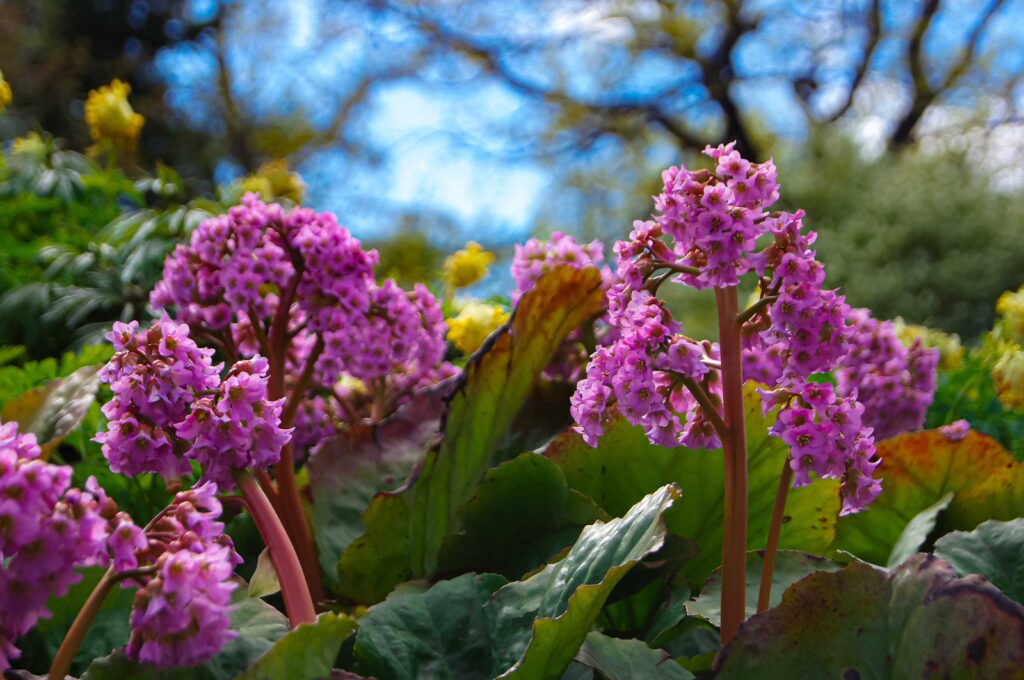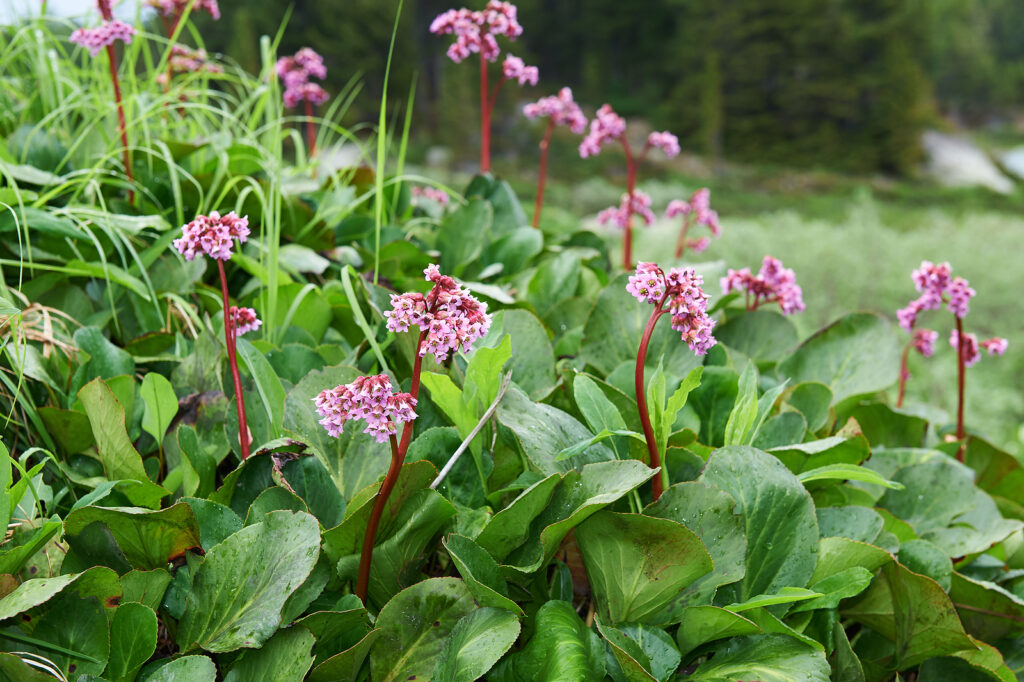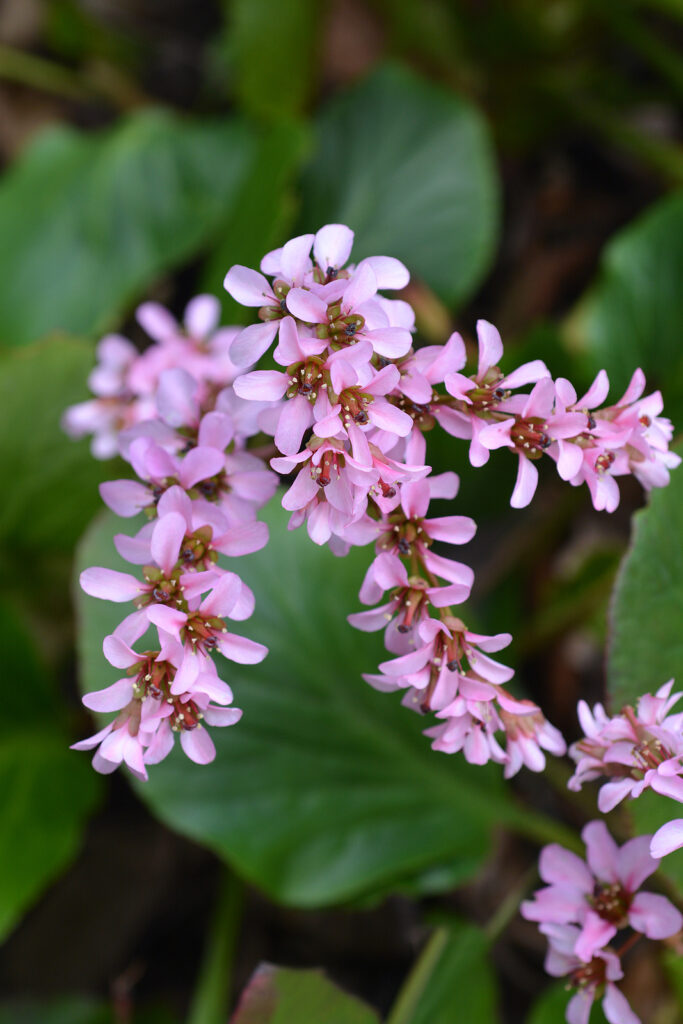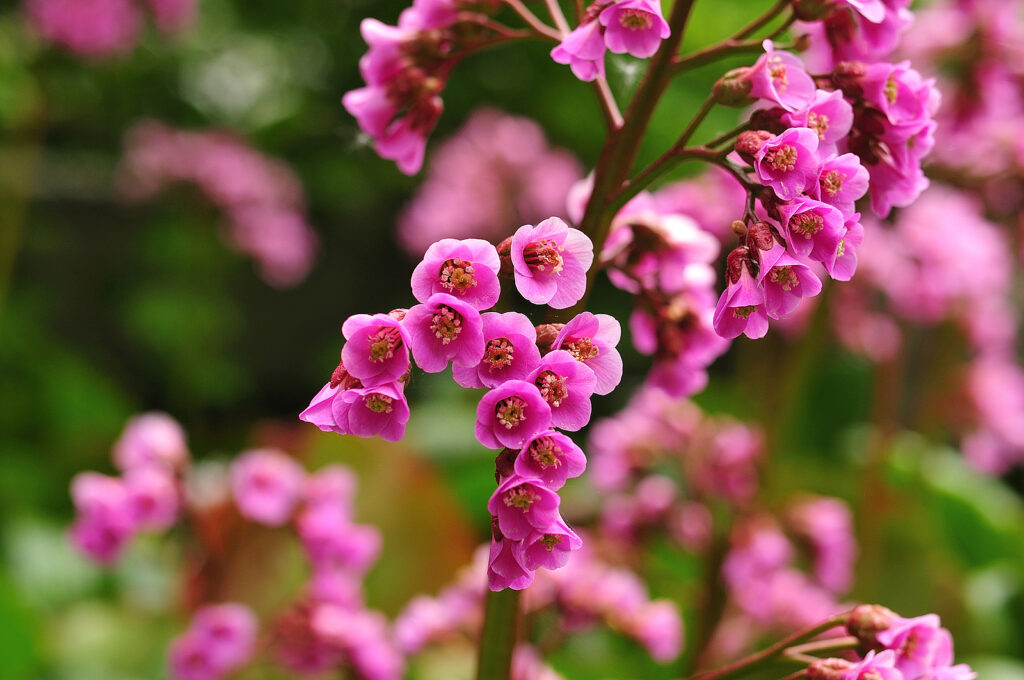Bergenia is commonly grown for its glossy decorative foliage and early spring flowers. Leaves are rounded or spoon-shaped and sometimes change to a shade of red and purple in autumn and winter.
Bell-shaped flowers that are pink, mauve, red, or white grow in loose clusters above or among the foliage. Bergenia is hardy, but early blooms can be damaged by frost.
In winter, Bergenia leaves turn red, burgundy, and green adding color to the winter garden. The winter color fades in spring just as Bergenia begins to flower.
There are about 8 species in the genus; all grow from branching rhizomes that slowly spread into clumps about 12 inches (30cm) wide.

Get to know Bergenia
- Plant type: Perennial
- Growing zones and range: 3 to 9 depending on the variety
- Hardiness: Evergreen except in the coldest regions; early blooms can be damaged by frost
- Height and width: 18 to 24 inches (45-61cm) tall and 12 to 18 inches (30-45cm) wide
- Foliage: Large, glossy green, cabbage-shaped leaves 8 to 12 inches (20-30cm) long and 8 inches wide
- Flowers: Nodding clusters of small bell or funnel-shaped flowers
- Flower colors: Red, purple, pink, are white
- Bloom time: Spring
- Uses: Borders, under trees, woodland garden, groundcover
- Common name: Bergenia
- Botanical name: Bergenia
- Family name: Saxifragaceae
- Origin: Himalayas
Where to plant Bergenia
- Plant Bergenia in dappled or partial shade; will take full sun in cool-summer regions where the soil stays moist.
- Grow Bergenia in humus-rich, well-drained soil; plants can tolerate poor soil.
- Plant Bergenia where it is sheltered from the wind.
Bergenia uses and companions
- Plant Bergenia in front of aucubas, rhododendrons, Japanese aralia
- Companion plants well-suited for Bergenia include ferns, hellebores, and hostas.
- Other suitable companions include Anemone hybrida, Astilbe, Brunner macrophylla, Digitalis, Polygonatum, Thalictrum.

When to plant Bergenia
- Plant container-grown plants from mid-autumn to early spring.
Planting and spacing Bergenia
- Space 12 to 24 inches (30-61cm) apart depending on the variety.
- Set container-grown plants in the garden in spring or autumn.
How to water and feed Bergenia
- Bergenia grows best if the soil is kept just moist, not wet, and not dry.
- Fertilize Bergenia in spring with an all-purpose fertilizer.

Bergenia care
- Mulch in autumn when winter weather can turn cold.
- Protect Bergenia from strong winds.
- Divide clumps that have died out in the center.
Bergenia pests and diseases
- Leaf spot fungus can cause brown patches on leaves.
- Bergenia can be prone to attack by weevils, slugs, snails, and caterpillars.
Bergenia propagation
- Divide plants in autumn or spring.
- Take cuttings from rhizomes that have a rosette of foliage attached.
- Species can be started from seed in a cold frame in spring.
- Seeds need light to germinate. Seeds germinate in 3 to 6 weeks at 70° to 75°F (21°-24°C).

Bergenia varieties to grow
- Bergenia ciliata: Grows to 12 inches (30cm) tall and wide; light green leaves with smooth edges; white, rose, or purplish flowers bloom late spring and summer; hardy to -10°F (-23°C).
- B. cordifolia, heartleaf Bergenia: Glossy, heart-shaped leaves; rose or lilac flowers in pendulous clusters in spring; hardy to -30°F (-34°C).
- B. crassifolia, winter-blooming Bergenia: Dark green leaves 8 inches across; flowers are rose, lilac, or purple in dense clusters on erect stems; plants grow to 20 inches tall; hardy to -30°F (-34°C).
- B. hybrids: Many hybrids including ‘Evening Glow’ and ‘Silver Light.’
Bergenia frequently asked questions
Q: What does Bergenia need to grow well?
A: Bergenia can tolerate almost any soil. It grows best in humus-rich, moist, well-drained soil either in full sun or light shade.
Q: How can I propagate Bergenia?
A: Divide Bergenia in autumn or spring. You can also grow Bergenia from seed sown indoors or in a cold frame in early spring. Divide Bergenia by using a sharp knife to cut the thick, rhizome-like, prostrate stems.
Q: What root system does Bergenia have?
A: Bergenia has thick, rhizome-like prostrate stems. You can divide these stems to create new plants.















